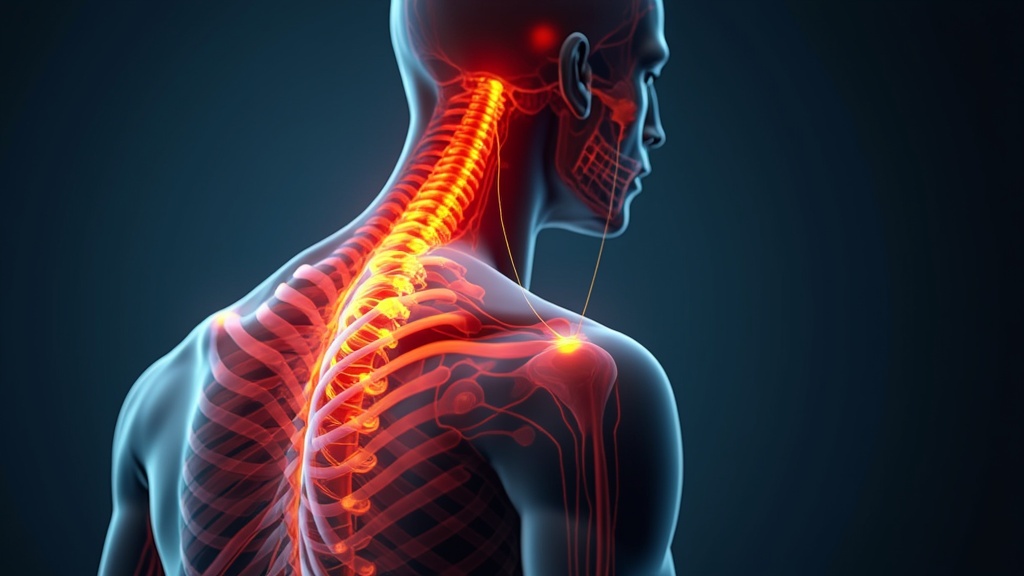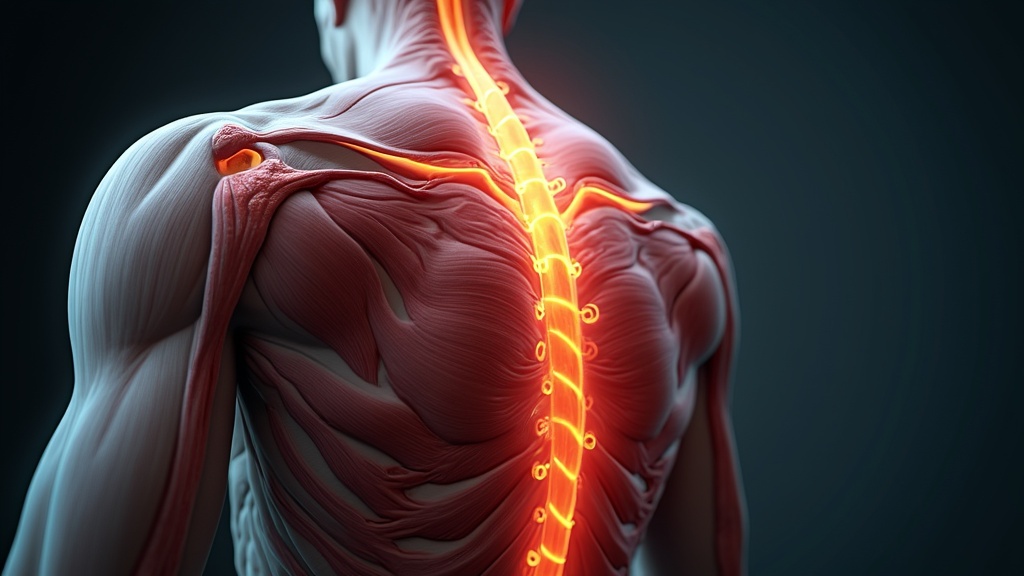
Experiencing muscle pain can significantly interfere with everyday activities, causing discomfort and frustration. Myofascial trigger points, often overlooked, are key contributors to this pain.
These hyperirritable spots within muscle fibers create localized tension, which may lead to referred pain in other body areas.
The impact of these trigger points is essential for effective pain management strategies.
Trigger point therapy, a technique focused on releasing muscle tightness, has gained recognition for its ability to alleviate discomfort and restore range of motion. This holistic approach can enhance overall wellness and support muscle recovery.
Understanding Muscle Knots And Their Causes
Muscle knots are complex physiological phenomena that can disrupt normal muscle function.
These taut bands form due to improper mechanics within muscle fibers. They can create significant tension, leading to discomfort and restricted movement.
Poor posture frequently contributes to muscle imbalances, further aggravating the formation of knots.
Repetitive movements, both in occupational settings and recreational activities, can exacerbate this condition.
The Role of Hydration in Muscle Health
Maintaining optimal hydration is vital for muscle elasticity.
Dehydration significantly increases the risk of spasms and tightness. Proper hydration supports muscle function and enhances overall athletic performance.
The Importance of Nutrition
Proper nutrition plays a critical role in muscle health. It provides essential vitamins and minerals that support muscle function, enhance recovery, and prevent future issues.
A balanced diet contributes to maintaining energy levels and promotes overall wellness.

What Is Trigger Point Therapy
Trigger point therapy specifically targets hyperirritable spots in muscle fibers, referred to as muscle knots, to effectively relieve discomfort. This therapeutic approach distinguishes itself from techniques like deep tissue massage and acupuncture by focusing on myofascial trigger points, which can lead to referred pain in other areas of the body.
Individuals suffering from chronic pain conditions, such as fibromyalgia, can find significant symptom relief through this targeted method.
Both sports injuries and postural issues can benefit from trigger point therapy.
To find a qualified therapist, potential clients should consider checking professional directories, seeking recommendations from healthcare providers, and looking for specialists in myofascial release.
Pain Management Techniques For Muscle Tightness
A comprehensive approach to pain management incorporates various techniques for muscle tightness, including both passive and active methods. Passive techniques, such as myofascial release therapy and heat therapy, provide immediate tension relief and promote muscle recovery.
Active techniques, including stretching and strengthening exercises, enhance overall muscle function and contribute to long-term wellness.
Passive Techniques
Passive techniques are critical for any treatment regimen aimed at addressing muscle tightness. Examples include:
- Myofascial Release Therapy: This approach focuses on relieving tension in the connective tissue surrounding muscles.
- Heat Therapy: Applying heat can increase blood flow to the affected areas, aiding in muscle recovery.
Active Techniques
Active techniques involve the patient in their own treatment, promoting engagement and longer-lasting results. These methods include:
- Stretching Exercises: Regular stretching improves flexibility and range of motion, reducing stiffness.
- Strengthening Exercises: Building muscle strength helps support proper body mechanics and posture.
It is essential to adopt a personalized approach, as responses to treatment can vary greatly among individuals. Mental health conditions can significantly influence pain perception, making effective stress management an important component of any pain relief strategy. Integrating mindfulness and relaxation techniques can further enhance therapeutic outcomes and overall wellness.
| Technique | Description |
|---|---|
| Myofascial Release Therapy | Relieves tension in the connective tissue surrounding muscles. |
| Heat Therapy | Increases blood flow to affected areas, aiding in muscle recovery. |
| Stretching Exercises | Improves flexibility and range of motion, reducing stiffness. |
| Strengthening Exercises | Builds muscle strength to support proper body mechanics and posture. |
How Does Dry Needling Work
Dry needling is a targeted technique aimed at releasing muscle knots, focusing specifically on myofascial trigger points. This method involves inserting thin needles into hyperirritable spots within the muscle fibers, eliciting a local twitch response that may relieve tension and reduce discomfort.
Many patients experience quick pain relief and improved muscle function after treatment.
Unlike traditional massage therapy, which often addresses symptoms, dry needling seeks to eliminate the root causes of pain by focusing on active trigger points.
To maximize effectiveness, proper aftercare is essential; staying hydrated and engaging in gentle stretching are recommended practices for optimal recovery.
Benefits Of Massage Therapy For Relaxation
Various types of massage therapy provide numerous benefits for relaxation and stress relief. Below are several techniques along with their specific advantages:
- Swedish massage: Known for its gentle strokes, it enhances circulation and reduces stress.
- Deep tissue massage: Targets deeper muscle layers, providing relief from chronic pain.
- Aromatherapy massage: Incorporates essential oils, further enhancing relaxation through the power of scent.
The psychological effects of massage therapy can significantly lower cortisol levels while stimulating endorphin release, contributing to improved mood and sleep quality. When selecting a therapist, it is advisable to consider the following tips:.
- Check qualifications to ensure expertise in therapeutic modalities.
- Discuss specific needs with the therapist to personalize the experience.
- Look for recommendations and reviews to gauge client satisfaction.
By understanding the various techniques, their benefits, and how to choose a skilled professional, individuals can optimize their experience with massage therapy and achieve greater stress management and overall welfare.
Dry Needling and Massage Therapy
- Research indicates that dry needling can lead to a significant reduction in pain for patients suffering from myofascial pain syndrome.
- A study found that massage therapy can decrease anxiety levels by up to 30%, promoting overall mental well-being.
- According to a survey, 90% of individuals reported improved sleep quality after receiving regular massage therapy.
- Dry needling has been shown to improve range of motion in patients with musculoskeletal disorders, enhancing overall physical function.
Exploring Referred Pain And Its Impact
Referred pain can complicate clinical assessments, frequently presenting at locations distinct from the originating source. Recognizing referred pain patterns is essential; failure to identify underlying issues may mislead healthcare providers. By accurately identifying these patterns, treatment effectiveness can improve significantly, enabling more targeted approaches to relief.
Patients should utilize specific language when describing their symptoms; this includes detailing the location and intensity of discomfort. Effective communication strategies empower patients, promoting a clearer dialogue with healthcare providers, which ultimately facilitates better diagnosis and enhances treatment outcomes, contributing to effective pain management.
Communication Strategies for Patients
Implementing effective communication strategies enhances patient-provider interactions. Patients are encouraged to:
- Clearly describe the intensity and nature of their discomfort.
- Identify patterns of pain and any triggers that may exacerbate symptoms.
- Take note of how pain may radiate to other areas.
Empowering communication ultimately leads to improved understanding and management of referred pain.
Physical Therapy For Chronic Pain Treatment
Physical therapy plays a pivotal role in managing chronic pain conditions, effectively addressing the underlying musculoskeletal issues that contribute to discomfort. Implementing tailored exercise programs is vital, as they cater to individual recovery needs and limitations, thereby optimizing rehabilitation outcomes. Incorporating various therapeutic modalities, such as trigger point therapy and soft tissue manipulation, enhances treatment effectiveness.
Importance of Tailored Exercise Programs
Custom exercise programs help patients engage with their recovery process. Benefits include:
- Addressing specific areas of muscle tightness and stiffness.
- Promoting range of motion and overall muscle function.
- Facilitating injury prevention through proactive strategies.
A personalized approach in physical therapy fosters a comprehensive perspective on pain management.
By integrating multiple therapies, a holistic approach emerges, emphasizing the importance of various treatment modalities. Evidence-based practices in physical therapy demonstrate significant potential for symptom relief, promoting improved function and overall wellness through active engagement in one’s recovery journey.
Referred Pain and Physical Therapy
- Studies indicate that up to 50% of patients experience referred pain, complicating diagnosis and treatment.
- Effective communication about pain can lead to a 30% increase in accurate diagnoses by healthcare providers.
- Tailored exercise programs in physical therapy can improve patient outcomes by up to 40% in chronic pain management.
- Research shows that integrating multiple therapeutic modalities can enhance symptom relief and functional improvement in patients.
Effective SelfCare Strategies For Tension Relief
Implementing effective self-care strategies can significantly alleviate tension in your muscles. Establishing a consistent daily routine is essential for reducing muscle tightness and discomfort.
Begin your day with stretching exercises, focusing on major muscle groups to enhance flexibility and promote better posture.
Practicing mindfulness techniques, such as deep breathing exercises, can facilitate stress relief while heightening body awareness, which addresses the underlying causes of muscle knots.
Daily Routines for Muscle Recovery
Incorporating self-massage tools, like foam rollers, aids in trigger point therapy, effectively releasing hyperirritable spots and taut bands in muscle fibers.
Consider utilizing apps that guide you through relaxation techniques and therapeutic exercises tailored to your needs. By integrating these self-care practices into your life, you can manage tension relief more effectively and improve your overall wellness.
Tools and Resources for Stress Management
Utilizing resources such as instructional videos or guided meditation apps can enhance your understanding of relaxation techniques.
These tools contribute to pain management and muscle recovery by promoting deeper relaxation and improved muscle function. Regular engagement in these practices supports injury prevention and aids in rehabilitation, allowing for greater range of motion and improved ergonomics.
Self-Care Strategies
- Regular stretching can improve flexibility and reduce muscle tightness.
- Mindfulness practices, such as deep breathing, can lower stress levels and enhance body awareness.
- Self-massage tools like foam rollers are effective in releasing muscle knots and improving recovery.
- Guided relaxation techniques can promote better muscle function and aid in injury prevention.
